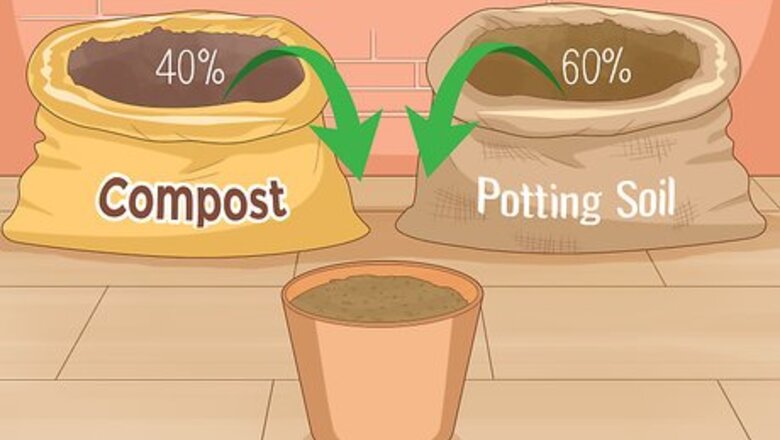
views
X
Research source
The leaves are also said to have antioxidants and help stabilize blood sugar.[2]
X
Research source
While you can always buy curry leaves online or from Indian grocery stores, you can also grow the plants in your own yard to harvest yourself. Curry leaf plants are low maintenance, and all you need to start are some seeds, potting mix, and a small pot. As your plant grows taller, you’ll be able to harvest the leaves to use in your own dishes!
Planting Your Curry
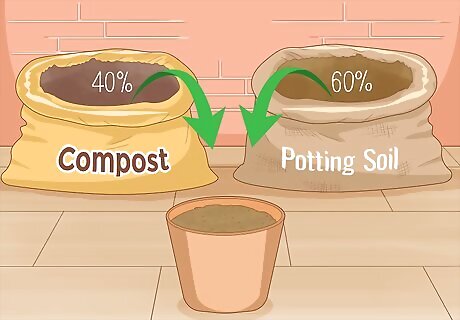
Fill a small pot with a mix of potting soil and compost. Look for a small pot that’s about 4–6 inches (10–15 cm) tall and 3–4 inches (7.6–10.2 cm) wide for starting your curry leaf plant. Make a potting mix that’s 60% potting soil and 40% compost so your plant gets enough nutrients while it’s growing. Combine the soil and compost thoroughly until it’s thoroughly mixed together. Use store-bought potting soil rather than soil from your yard to ensure that it doesn’t have any harmful bacteria. If you live in an area with climate zones 9-12 or the temperature doesn’t fall below 32 °F (0 °C), you can put your curry leaf plant directly in the ground. Make sure to amend the soil so it has the proper nutrients. If you want to grow more than 1 curry leaf plant, then prepare multiple pots for each additional plant you want.
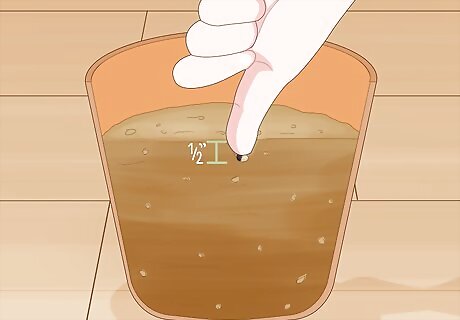
Push a curry leaf plant seed ⁄2 in (1.3 cm) into the potting mix. Push your thumb into the center of the soil so it makes a hole that’s ⁄2 inch (1.3 cm) deep. Take a single seed for a curry leaf plant and drop it into the hole you just made. Push some of the potting mix back into the hole to cover the seed, and compact it slightly so it’s pressed against the seed. You can get curry leaf plant seeds online or from Indian food markets. Get the freshest seeds available for the best chances of them sprout.Tip: You can also grow a curry leaf plant from a fresh cutting off of a larger plant. Push the stem so it’s 2–3 inches (5.1–7.6 cm) deep in the potting mix. Make sure the cutting has at least 2-3 leaves on it so it can grow easily.
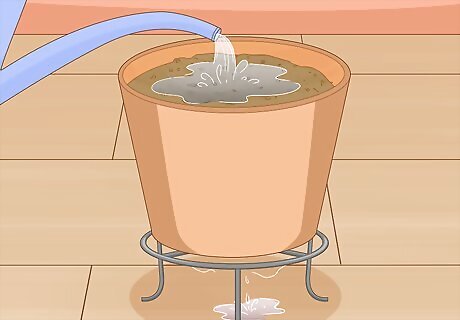
Water the soil thoroughly until you see it come out of the drainage holes. After you’ve placed the seed in the soil, use a watering can to wet the soil so the roots can start growing. If there’s standing water on top of the soil, wait for it to absorb deeper before adding more water. As soon as the water starts coming out of the drainage holes at the bottom of the pot, then stop watering the plant. Keep the pot inside a shallow container so the soil can absorb any water that drains out from the bottom. Be careful not to overwater the seeds since they may not sprout or grow well if there’s too much.
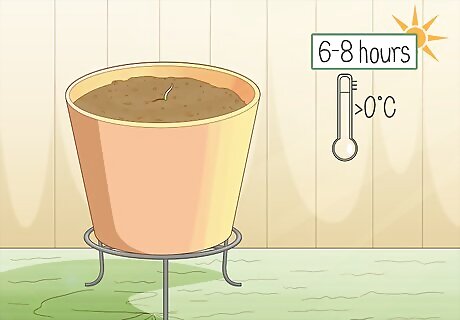
Put the pot in an area that gets at least 6 hours of sunlight per day. After you’ve watered your seeds, set them near a south-facing window so they can get sunlight throughout the day. If you have weather that’s above 32 °F (0 °C), you can also keep the pot outside for the plant to grow. Make sure the plant gets full sun, or 6-8 hours, during the day, or else it won’t produce strong shoots or leaves. After about 7 days, you may see your curry leaf plants sprouting out from the soil. If the temperature doesn’t drop below 32 °F (0 °C) until the evening, then keep your plant outside during the day and bring it inside at night so it doesn’t freeze or die.
Caring for the Plant
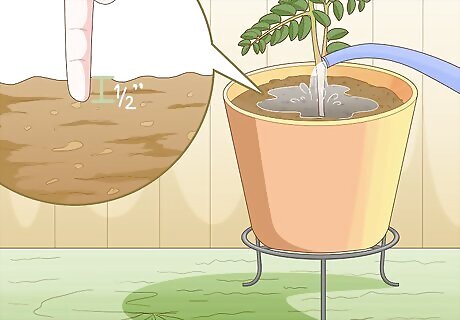
Water your curry plant when the soil is dry ⁄2 in (1.3 cm) down. Check the soil in your curry leaf plant’s pot every other day to see if it feels dry to the touch. If it doesn’t feel moist when you put your finger ⁄2 in (1.3 cm) into the soil, then use your watering can until the water comes out of the drainage holes at the bottom of the pot. Be careful not to overwater your plants since it could make them weaker and they may not produce as many leaves.
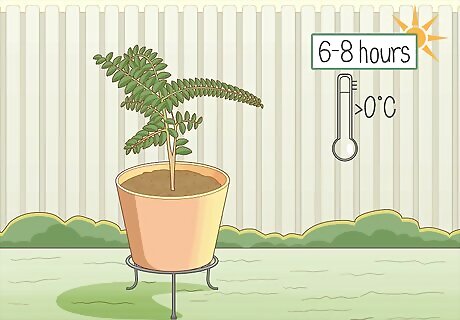
Keep the plant in a sunny area throughout the day. Put the plant in an area that gets full sun throughout the day, which should be around 6-8 hours daily. You can either put the pot outside if the temperature is above 32 °F (0 °C), or you can keep it near a south-facing window so it can continue to grow. Let the plant get direct sunlight so it can create healthy growth and leaves. If your plant doesn’t get full sun throughout the day, it may drop some of its leaves and grow weak. As long as you keep watering the plant, the leaves may grow back during the next season.
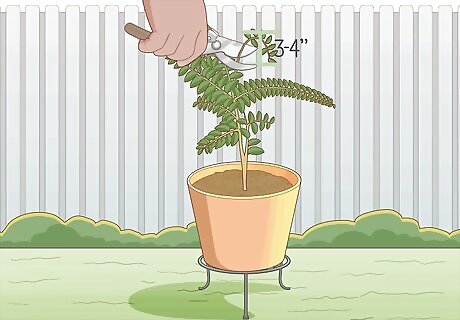
Prune the top 3–4 in (7.6–10.2 cm) off of the plant yearly. Check your plant in the spring after you planted it, and note any tall vertical growths that don’t have many leaves growing off of them. Use a pair of gardening snips to remove the top 3 inches (7.6 cm) just below one of the nodes where the leaves connect. Make your cut at a 45-degree angle so your plant doesn’t start to rot on its stem. Pruning your plant not only keeps it at a reasonable size, but it also helps promote health leaf growth on the stems that you leave attached. If you notice any weak, broken, or wilted stems, then also remove them so your plant can put its energy toward growing healthy leaves.
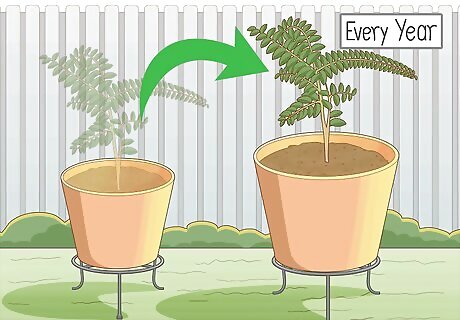
Move the plant into a new pot each year to promote healthy growth. Curry leaf plants continuously grow to fit the size of their container, so they need to switch pots every year. Grab the base of the plant’s stem and carefully pull it out of the pot. Find a pot that’s twice as wide as the plant’s root ball and fill it halfway with a potting mix that’s 60% potting soil and 40% compost. Break apart any dirt clumps around the roots and set the plant into its new pot. Fill in the dirt around it and water it thoroughly so it doesn’t go into shock. Wear gardening gloves while working with your plant in case you have any allergic reactions to the sap. If the plant is stuck in the pot, use a shovel or trowel around the edge of the pot to help loosen it.Warning: Don’t use too large of a pot right away since the plant will put most of its energy into growing the roots.
Harvesting the Leaves
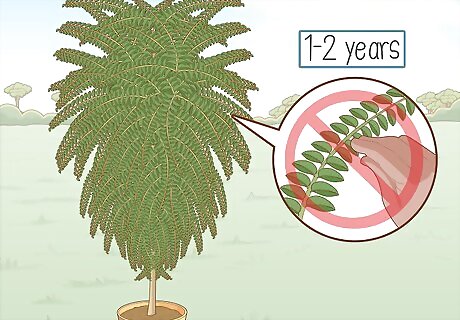
Wait until your plant is at least 1-2 years old before taking any leaves. New curry leaf plants don’t have enough leaves to harvest and continue growing while they’re young, so wait until your plant is at least 1 year old. If you plant is still thin or only has a few stems with leaves on them after a year, let it keep growing until it’s filled out. If you planted your curry leaf plant from a cutting, then it may be full enough after a few months to harvest some of the leaves.
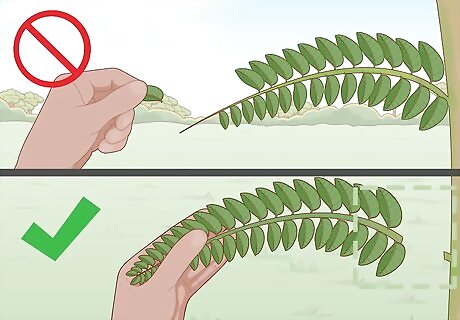
Pull the base of the leaf stem from the plant when you’re ready to harvest. Don’t pull off the leaves individually since it leaves a lot of empty growth on the plant. Instead, look where the long stem that connects multiple leaves attaches to the main body of the plant. Grip the stem by its base and lightly pull it off the plant to collect all of the leaves attached to it. Only harvest what you immediately need so the plant can continue growing. You can harvest up to 30% of the plant’s leaves. If you harvest more, the plant may not grow as well the following year.
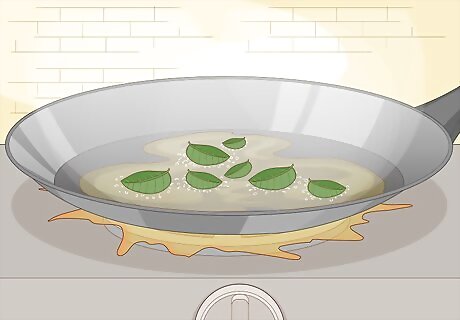
Fry fresh curry leaves within 2-3 days to use in your dishes. Warm vegetable oil in a frying pan over medium-low heat so it starts bubbling. Lay your fresh curry leaves in the oil and let them pan-fry for 1-2 minutes to enhance their flavor. Add the leaves to your dish and cook them until they have a light crisp. Use your curry leaves in dishes like Indian curry, masala, and coconut rice. Unlike bay leaves, you can leave curry leaves in your dish and eat them when they’re finished cooking.Tip: Curry leaves have a different flavor than curry powder, so don’t use them as a substitute ingredient.
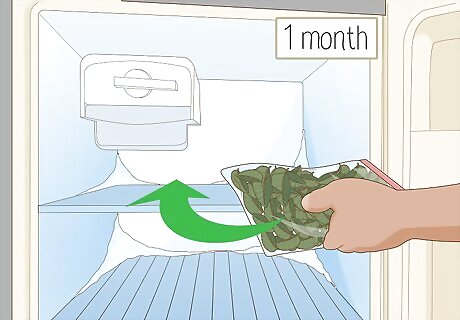
Freeze your fresh curry leaves for up to 1 month to preserve them. Put the curry leaves inside of a resealable plastic bag and press as much air out of the bag as you can before sealing it. Use a marker to write the date so you know when you froze them. Set the curry leaves in your freezer and keep them there for up to 1 month so you can use them later. When you want to use your frozen leaves, put them directly in a pan with vegetable oil to heat them.
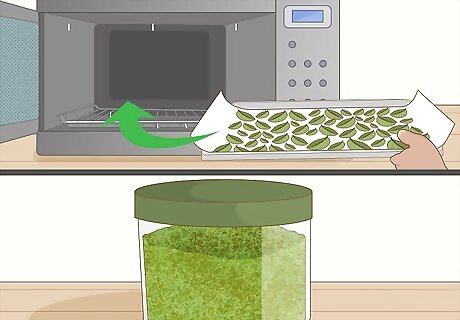
Dry the leaves if you want to sprinkle them on your food later on. If you have a lot of leaves and you aren’t able to use them all immediately, lay them flat on a baking sheet and preheat your oven to the lowest temperature setting it has. Let the herbs cook for 30 minutes before flipping them over with a pair of tongs. Leave the herbs in the oven for another hour to dry them. Once they’re dried out, crumble the leaves into a jar and seal them tightly. Dried curry leaves don’t have as strong of a flavor as fresh leaves, so use more in your recipe until you’re happy with the flavor.



















Comments
0 comment